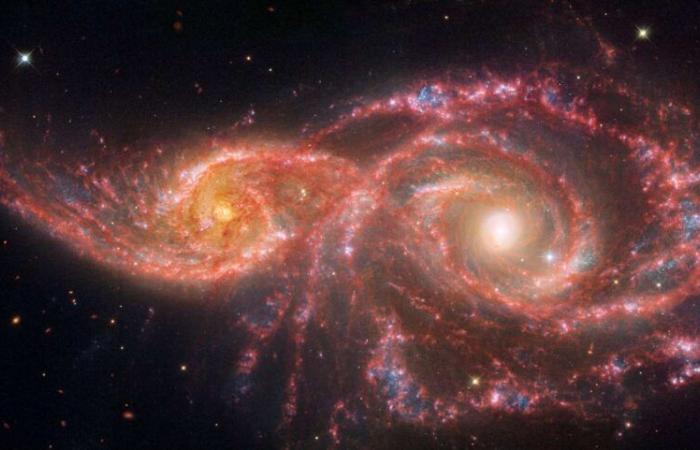The Hubble Space Telescope is well known for its spectacular images of galaxy collisions. He has just teamed up with the James-Webb space telescope, the JWST, to revisit the representations and knowledge we have of an iconic collision observed for almost two centuries in the constellation Grand ChienChien with a resolutionresolution increasingly increased and in wavelengths other than those of the visible band.
It was in fact in 1835 that theastronomerastronomer British John Herschel (the son of William HerschelWilliam Herscheldiscoverer ofUranusUranus and infrared rays, among others) made the discovery of the pair of galaxies spiralesgalaxies spiralestoday cataloged under the names IC 2163 and NGCNGC 2207. They are in the process of gravitational interaction and will merge in several hundred million years to give a large elliptical galaxyelliptical galaxy.
This video shows two spiral galaxies, IC 2163 on the left, and NGC 2207 on the right, located 114 million light years from Earth. The journey begins and ends with a new image that combines mid-infrared, visible and ultraviolet rays from the James Webb and Hubble space telescopes, and includes brief fades into Webb’s mid-infrared image and the visible and ultraviolet image of Hubble. Watch these fascinating observations break down and then present themselves again as a combined observation. The tour features star formation in frightening detail, blood-red shock fronts, and traces of ancient supernova explosions that “resonate” across the cosmic landscape. To obtain a fairly accurate French translation, click on the white rectangle at the bottom right. English subtitles should then appear. Then click on the nut to the right of the rectangle, then on “Subtitles” and finally on “Automatically translate”. Choose “French”. © NASA, ESA, CSA, STScI, Danielle Kirshenblat (STScI)
A galactic collision for Halloween
In the meantime, the tidal forcestidal forces sculpt them and shock waves in the gazgaz interstellar formation of the two galaxies lead to significant outbreaks of star formationstarsstars some of which are massive and therefore evolve quickly before exploding. Four supernovaesupernovae were observed in the galaxy NGC 2207 between the years 1975 and 2013.
We can recall in passing that NGC 2207 was used by Gérard de Vaucouleurs as a galaxy of morphological type SAB(rs)bc in his Atlas of Galaxies in which the famous French astronomer used in 1959 his revision of the morphological classification of Hubble to hold accounts for more subtle features in the structure of galaxies, particularly for spiral and lenticular galaxies.
NASA and ESA put the images taken by Hubble and JWST online on Halloween with very rich comments which we are therefore using again.
Did you know?
Above is this image of the galaxies IC 2163 and NGC 2207, captured by the Hubble and James-Webb space telescopes. Hubble’s data comes from its Wide Field Planetary Camera 2 (WFPC2). Webb’s data comes from his Miri instrument (Mid-Infrared Instrument).
The image shows a scale bar, compass arrows and color key for reference.
The scale bar is labeled in light years at the top, which corresponds to the distance light travels in one Earth year. (It takes three years for light to travel a distance equal to the length of the scale bar.) One light year is approximately 9.46 trillion kilometers.
The scale bar is also labeled in arcminutes, which is a measure of angular distance in the sky. An arcsecond is equivalent to an angular measurement of 1/3,600 of a degree. There are 60 arcminutes in a degree and 60 arcseconds in an arcminute. (The full Moon has an angular diameter of about 30 arcminutes.) The actual size of an object that spans one arcsecond in the sky depends on its distance from the telescope.
The north and east arrows of the compass indicate the orientation of the image in the sky. Note that the relationship between north and east in the sky (viewed from below) is reversed compared to the direction arrows on a map of the ground (viewed from above).
This image shows the invisible wavelengths of ultraviolet, visible and mid-infrared, which have been translated into colors of visible light. The color key indicates which WFPC2 and Miri filters were used to collect the light. The color of each filter name is the visible light color used to represent infrared light passing through that filter.
© NASA, ESA, CSA, STScI






